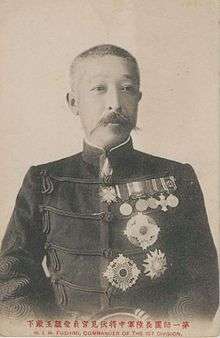Prince Fushimi Sadanaru
| Prince Fushimi Sadanaru | |
|---|---|
 Prince Fushimi Sadanaru in Meiji period postcard | |
| Born |
June 9, 1858 Kyoto, Japan |
| Died |
February 4, 1923 (aged 64) Chōshi, Chiba, Japan |
| Allegiance | Empire of Japan |
| Service/branch |
|
| Years of service | 1875-1923 |
| Rank | Field Marshal |
| Commands held | IJA 4th Division, IJA 1st Division, IJA 10th Division |
| Battles/wars |
First Sino-Japanese War Russo-Japanese War |
| Awards |
Supreme Order of the Chrysanthemum Order of the Golden Kite (2nd Class) |
| Other work | Lord Keeper of the Privy Seal of Japan |
Prince Fushimi Sadanaru (伏見宮貞愛親王 Fushimi-no-miya Sadanaru-Shinnō, June 9, 1858 – February 4, 1923) was the 22nd head of the Fushimi-no-miya shinnōke (branch of the Imperial Family).[1] He was a field marshal in the Imperial Japanese Army.
Early life
Prince Sadanaru was born in Kyoto as the fourteenth son of Prince Fushimi Kuniie (1802–1875) and was thus the half brother of Prince Yamashina Akira, Prince Kuni Asahiko, Prince Kitashirakawa Yoshihisa, and Prince Kan'in Kotohito. He succeeded his father as the head of the Fushimi-no-miya family in 1875.
Marriage & family
In 1872, Prince Fushimi Sadanaru married Princess Arisugawa Toshiko (1858–1927), the daughter of Prince Arisugawa Takahito, with whom he had one daughter and three sons.
- Prince Fushimi Hiroyasu (博恭王 Hiroyasu-ō, October 16, 1875 – August 16, 1946)
- Prince Fushimi Kunika (邦芳王 Kunika-ō, 1880-1933)
- Prince Fushimi Akinori (昭徳王 Akinori-ō, 1881-1883)
- Princess Fushimi Sachiko (禎子女王 Sachiko Joō, 1885-1966); married Count Toyokage Yamauchi.
Military career
.jpg)
A career army officer, Prince Sadanaru entered the military academy in 1873 and fought as a lieutenant in the Satsuma Rebellion. Promoted to captain in 1878, he studied military tactics at the École Spéciale Militaire de Saint-Cyr in France and later in Germany in the 1870s. Upon his return to Japan, he was promoted to major in 1881 and advocated the establishment of a Japanese version of an army General Staff based on the Prussian model. He was promoted to lieutenant colonel in 1884, colonel in 1887 and to major general in 1889. He was awarded the Grand Cordon of the Order of the Chrysanthemum in 1886.
Major General Prince Fushimi Sadanaru served as a field commander in the First Sino-Japanese War (1894–1895), commanding the IJA 4th Division, and landing with his forces in the Liaodong Peninsula, China in 1894. He subsequently participated in the 1895 Japanese invasion of Taiwan.
He represented Emperor Meiji at the coronation of Tsar Nicholas II of Russia on May 26, 1896. In 1898, he was promoted to lieutenant general and assigned command of the Himeji-based IJA 10th Division. In 1901, he became commander of the IJA 1st Division.
In 1904, with the start of the Russo-Japanese War he again landed with his forces in the Liaodong Peninsula. In June, he was promoted to full general, and recalled to Japan to serve on the Supreme War Council, before being sent by Emperor Meiji on a diplomatic mission to the United States. After the conclusion of the Treaty of Portsmouth, he was sent to England again on a mission of thanks from the Japanese government for British advice and assistance during the war. During this mission, he also stopped in Honolulu for a visit with the Japanese community there. In 1909, he was again sent on a diplomatic mission, this time to China. Prince Fushimi also represented Japan at the state funeral of Great Britain's King Edward VII May 20, 1910. He met with the new King George V at Buckingham Palace.
Prince Fushimi was a close advisor to then-Crown Prince Yoshihito (later Emperor Taishō). After the death of Emperor Meiji in 1911, he served as Lord Keeper of the Privy Seal of Japan from 1912 to 1915, thus becoming the only imperial prince to have served in that office.
He was promoted to the largely ceremonial rank of field marshal in 1915, and awarded the Grand Collar of the Supreme Order of the Chrysanthemum in 1916.
The Prince died of influenza on February 5, 1923 at his vacation home in Chōshi, Chiba and was accorded a state funeral. Dowager Princess Fushimi Toshiko died on January 3, 1930. Fushimi Sadanaru was succeeded by his son, Fleet Admiral Prince Fushimi Hiroyasu.
Honors
His Japanese decorations include the Collar and Grand Cordon of the Supreme Order of the Chrysanthemum, Grand Cordon of the Order of the Paulownia Flowers, Grand Cordon of the Order of the Sacred Treasure, Order of the Golden Kite (2nd Class). In addition, other honors and decorations included:
- Order of the Bath, Hon. Knight Grand Cross, 1907.[2]
- Order of St. Andrew, 1910.
Gallery
 HIH Fushimi Sadanaru in 1918
HIH Fushimi Sadanaru in 1918 HIH Fushimi Toshiko
HIH Fushimi Toshiko
Notes
- ↑ Takenobu, Yoshitaro. (1906). The Japan Year Book, p. 23., p. 23, at Google Books
- ↑ "Central Chancery of The Orders of Knighthood, Lord Chamberlains Office, St. James's Palace" (pdf). The London Gazette (11932). 7 May 1907. p. 493. Retrieved 15 February 2014.
The KING has been pleased to appoint General His Imperial Highness The Prince Sadanaru Fushimi of Japan to be an Honorary Member of the Military Division of the First Class, or Knights Grand Cross of the Most Honourable Order of the Bath.
References
- Dupuy, Trevor N. (1992). Encyclopedia of Military Biography. I B Tauris & Co Ltd. ISBN 1-85043-569-3.
- Jansen, Marius B. and Gilbert Rozman, eds. (1986). Japan in Transition: from Tokugawa to Meiji. Princeton: Princeton University Press. ISBN 9780691054599; OCLC 12311985
- ____________. (2000). The Making of Modern Japan. Cambridge: Harvard University Press. ISBN 9780674003347; OCLC 44090600
- Koyama, Noboru (2004). Japanese Students at Cambridge University in the Meiji Era, 1868-1912: Pioneers for the Modernization of Japan. Lulu.com. ISBN 1-4116-1256-6.
- Takenobu, Yoshitaro. (1906). The Japan Year Book. Tokyo: Japan Year Book Office. OCLC 1771764